Management Accounting Report: Tech (UK) Ltd. Performance Analysis
VerifiedAdded on 2020/12/24
|17
|3786
|118
Report
AI Summary
This report provides a comprehensive analysis of management accounting principles applied to Tech (UK) Ltd., a company specializing in mobile phone chargers and other gadgets. The report begins with an introduction to management accounting, differentiating it from financial accounting and highlighting its importance in performance appraisal, future planning, and risk assessment. It then delves into various management accounting systems like cost management and inventory management, including techniques such as FIFO, LIFO, and AVCO. Different types of managerial accounting reports, such as budget reports and accounts receivable reports, are discussed, emphasizing their role in cost reduction and decision-making. The report further explores cost calculation methods, comparing marginal and absorption costing, and includes income statements prepared using both methods. Finally, it examines different types of budgets, including operational, rolling, fixed, and flexible budgets, outlining their merits and demerits. The report concludes with a discussion on the use of management accounting to address financial problems, providing a holistic view of how accounting practices can drive effective business decisions.
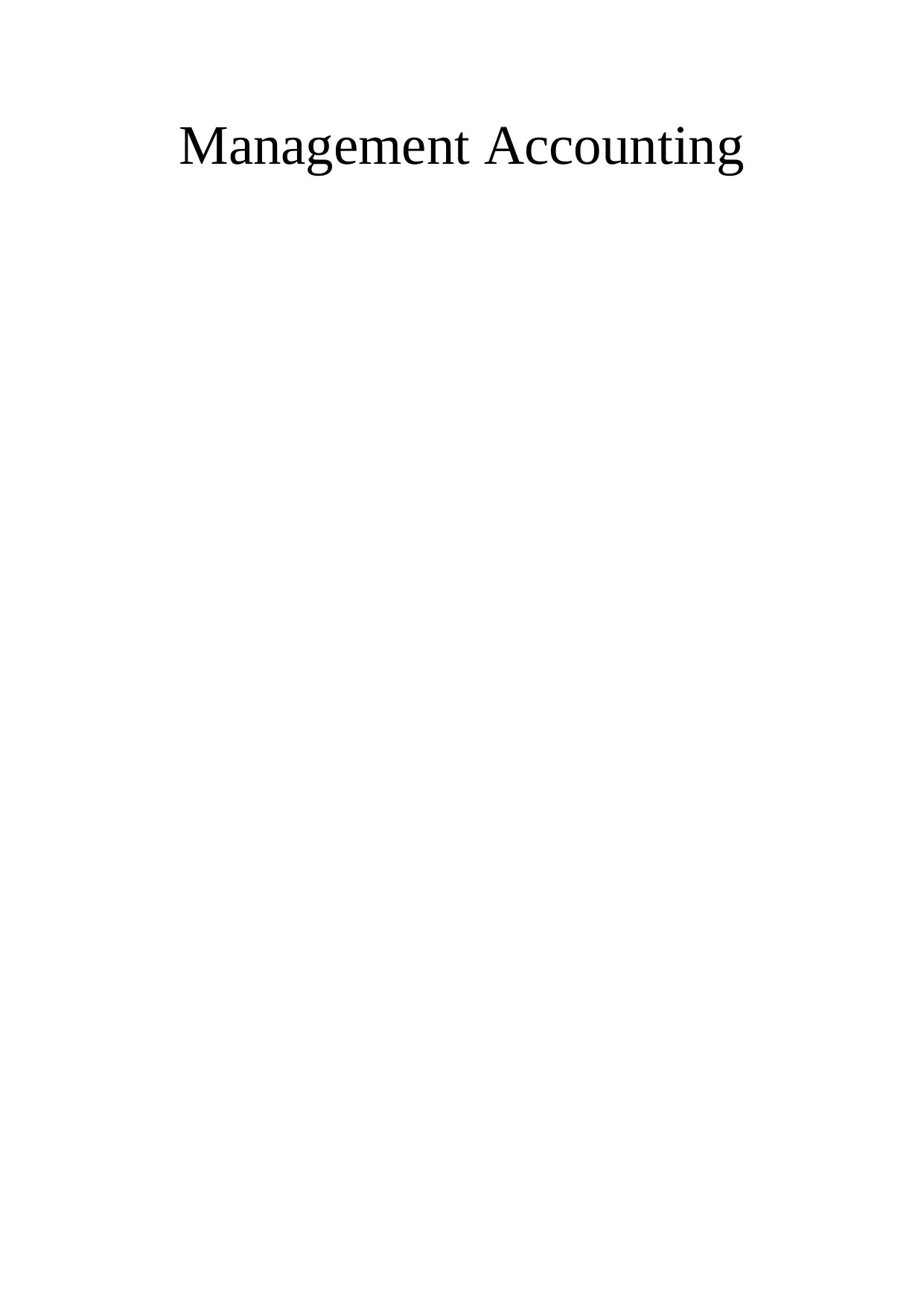
Management Accounting
Paraphrase This Document
Need a fresh take? Get an instant paraphrase of this document with our AI Paraphraser
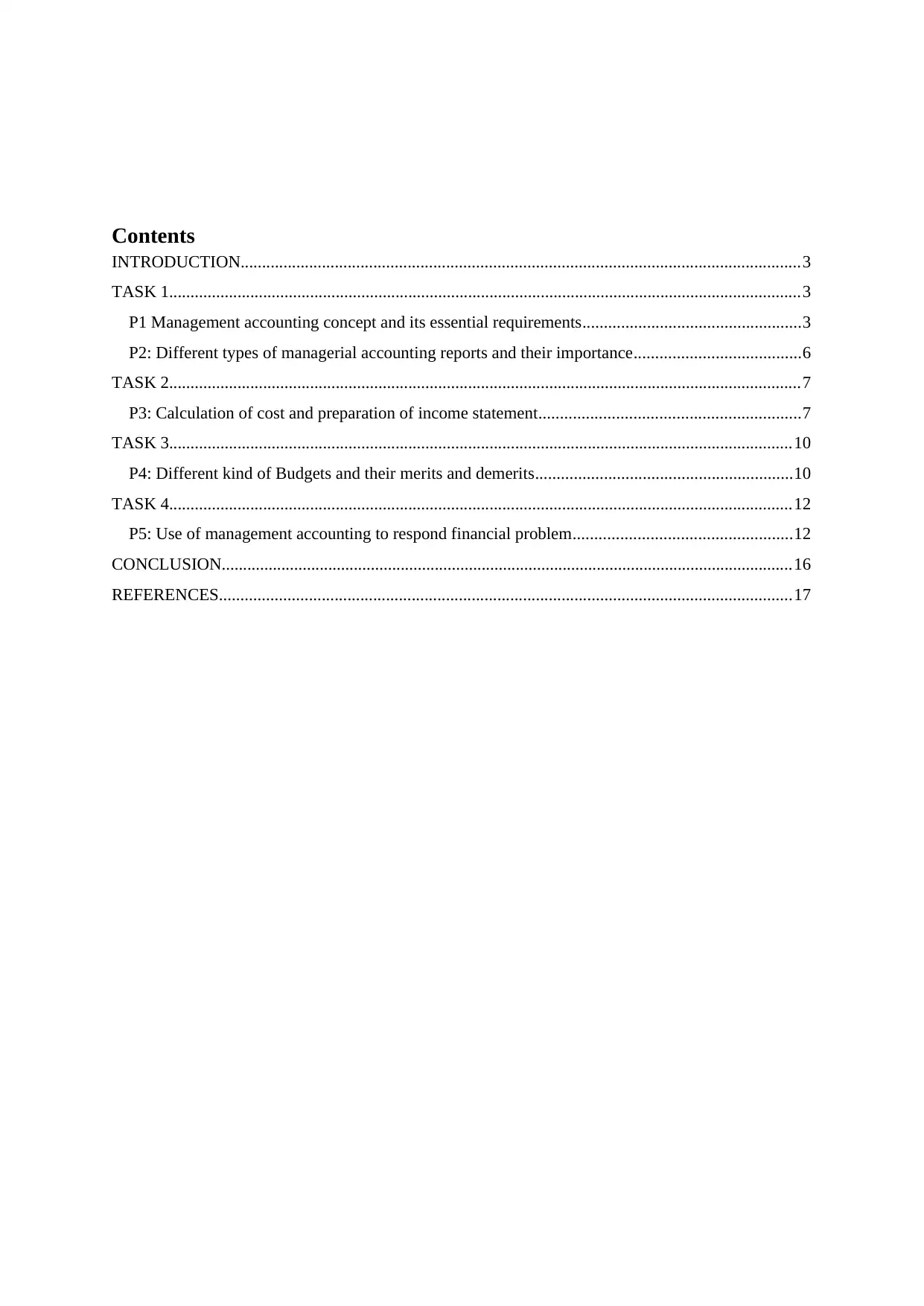
Contents
INTRODUCTION...................................................................................................................................3
TASK 1....................................................................................................................................................3
P1 Management accounting concept and its essential requirements...................................................3
P2: Different types of managerial accounting reports and their importance.......................................6
TASK 2....................................................................................................................................................7
P3: Calculation of cost and preparation of income statement.............................................................7
TASK 3..................................................................................................................................................10
P4: Different kind of Budgets and their merits and demerits............................................................10
TASK 4..................................................................................................................................................12
P5: Use of management accounting to respond financial problem...................................................12
CONCLUSION......................................................................................................................................16
REFERENCES......................................................................................................................................17
INTRODUCTION...................................................................................................................................3
TASK 1....................................................................................................................................................3
P1 Management accounting concept and its essential requirements...................................................3
P2: Different types of managerial accounting reports and their importance.......................................6
TASK 2....................................................................................................................................................7
P3: Calculation of cost and preparation of income statement.............................................................7
TASK 3..................................................................................................................................................10
P4: Different kind of Budgets and their merits and demerits............................................................10
TASK 4..................................................................................................................................................12
P5: Use of management accounting to respond financial problem...................................................12
CONCLUSION......................................................................................................................................16
REFERENCES......................................................................................................................................17
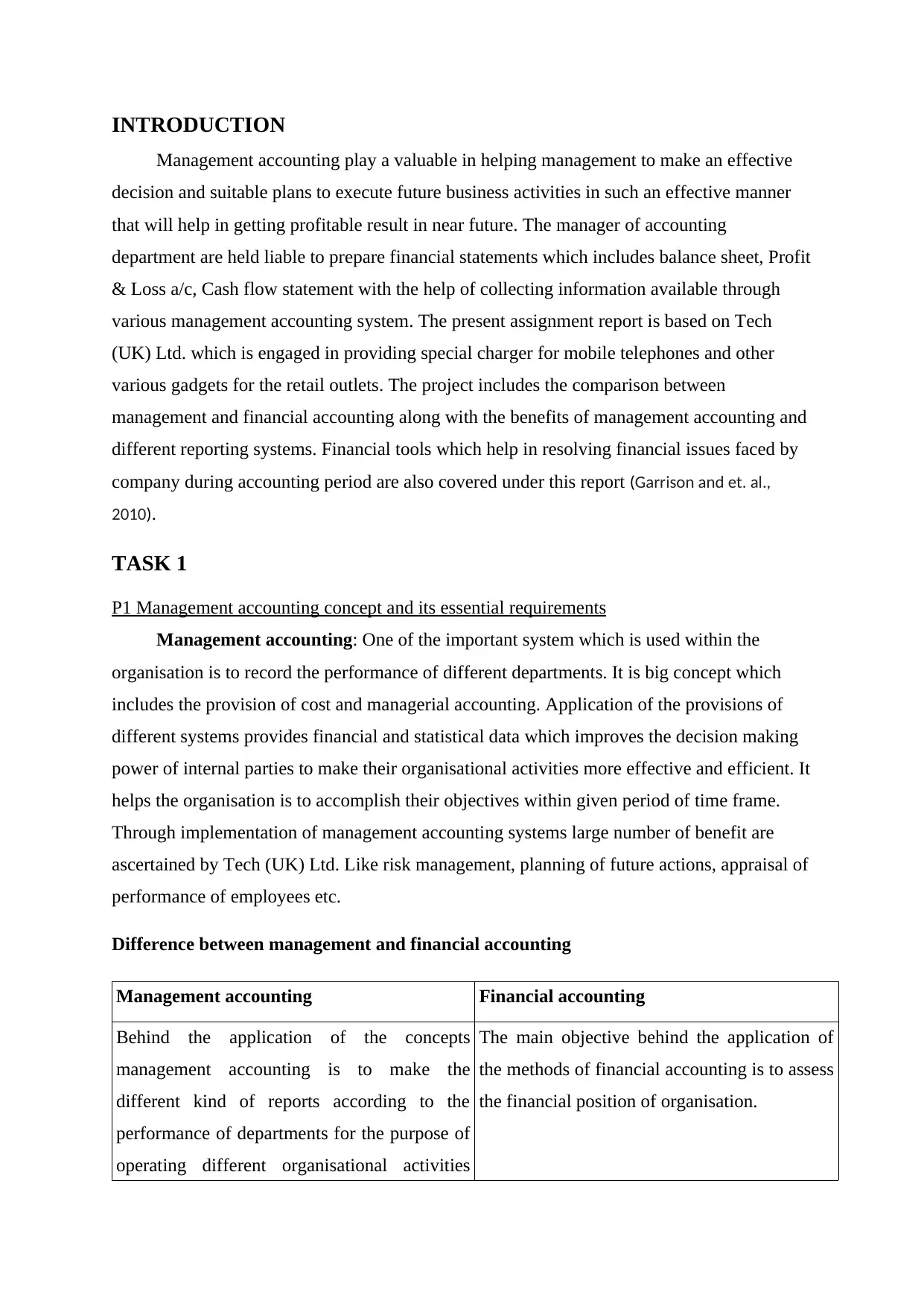
INTRODUCTION
Management accounting play a valuable in helping management to make an effective
decision and suitable plans to execute future business activities in such an effective manner
that will help in getting profitable result in near future. The manager of accounting
department are held liable to prepare financial statements which includes balance sheet, Profit
& Loss a/c, Cash flow statement with the help of collecting information available through
various management accounting system. The present assignment report is based on Tech
(UK) Ltd. which is engaged in providing special charger for mobile telephones and other
various gadgets for the retail outlets. The project includes the comparison between
management and financial accounting along with the benefits of management accounting and
different reporting systems. Financial tools which help in resolving financial issues faced by
company during accounting period are also covered under this report (Garrison and et. al.,
2010).
TASK 1
P1 Management accounting concept and its essential requirements
Management accounting: One of the important system which is used within the
organisation is to record the performance of different departments. It is big concept which
includes the provision of cost and managerial accounting. Application of the provisions of
different systems provides financial and statistical data which improves the decision making
power of internal parties to make their organisational activities more effective and efficient. It
helps the organisation is to accomplish their objectives within given period of time frame.
Through implementation of management accounting systems large number of benefit are
ascertained by Tech (UK) Ltd. Like risk management, planning of future actions, appraisal of
performance of employees etc.
Difference between management and financial accounting
Management accounting Financial accounting
Behind the application of the concepts
management accounting is to make the
different kind of reports according to the
performance of departments for the purpose of
operating different organisational activities
The main objective behind the application of
the methods of financial accounting is to assess
the financial position of organisation.
Management accounting play a valuable in helping management to make an effective
decision and suitable plans to execute future business activities in such an effective manner
that will help in getting profitable result in near future. The manager of accounting
department are held liable to prepare financial statements which includes balance sheet, Profit
& Loss a/c, Cash flow statement with the help of collecting information available through
various management accounting system. The present assignment report is based on Tech
(UK) Ltd. which is engaged in providing special charger for mobile telephones and other
various gadgets for the retail outlets. The project includes the comparison between
management and financial accounting along with the benefits of management accounting and
different reporting systems. Financial tools which help in resolving financial issues faced by
company during accounting period are also covered under this report (Garrison and et. al.,
2010).
TASK 1
P1 Management accounting concept and its essential requirements
Management accounting: One of the important system which is used within the
organisation is to record the performance of different departments. It is big concept which
includes the provision of cost and managerial accounting. Application of the provisions of
different systems provides financial and statistical data which improves the decision making
power of internal parties to make their organisational activities more effective and efficient. It
helps the organisation is to accomplish their objectives within given period of time frame.
Through implementation of management accounting systems large number of benefit are
ascertained by Tech (UK) Ltd. Like risk management, planning of future actions, appraisal of
performance of employees etc.
Difference between management and financial accounting
Management accounting Financial accounting
Behind the application of the concepts
management accounting is to make the
different kind of reports according to the
performance of departments for the purpose of
operating different organisational activities
The main objective behind the application of
the methods of financial accounting is to assess
the financial position of organisation.
⊘ This is a preview!⊘
Do you want full access?
Subscribe today to unlock all pages.

Trusted by 1+ million students worldwide
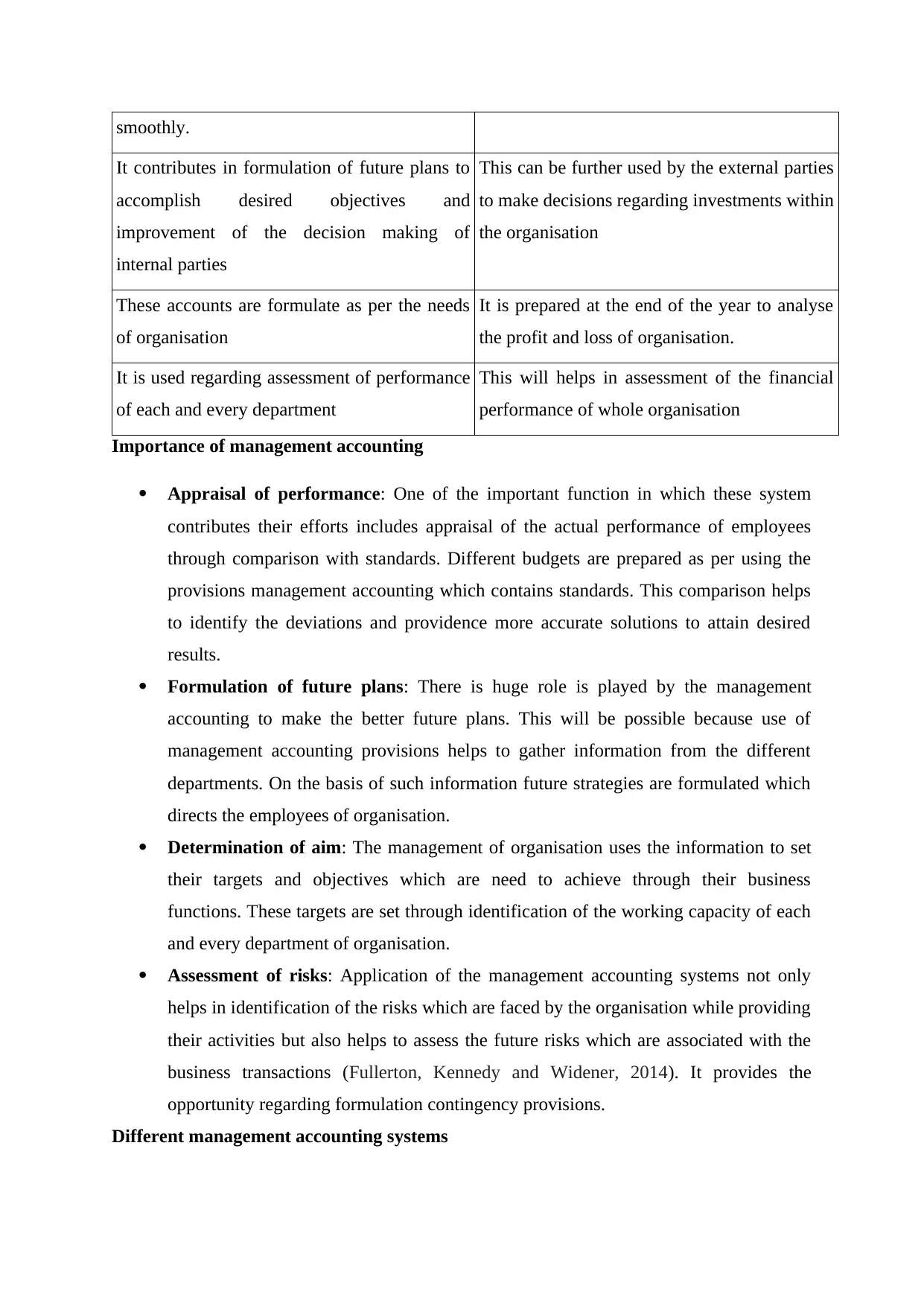
smoothly.
It contributes in formulation of future plans to
accomplish desired objectives and
improvement of the decision making of
internal parties
This can be further used by the external parties
to make decisions regarding investments within
the organisation
These accounts are formulate as per the needs
of organisation
It is prepared at the end of the year to analyse
the profit and loss of organisation.
It is used regarding assessment of performance
of each and every department
This will helps in assessment of the financial
performance of whole organisation
Importance of management accounting
Appraisal of performance: One of the important function in which these system
contributes their efforts includes appraisal of the actual performance of employees
through comparison with standards. Different budgets are prepared as per using the
provisions management accounting which contains standards. This comparison helps
to identify the deviations and providence more accurate solutions to attain desired
results.
Formulation of future plans: There is huge role is played by the management
accounting to make the better future plans. This will be possible because use of
management accounting provisions helps to gather information from the different
departments. On the basis of such information future strategies are formulated which
directs the employees of organisation.
Determination of aim: The management of organisation uses the information to set
their targets and objectives which are need to achieve through their business
functions. These targets are set through identification of the working capacity of each
and every department of organisation.
Assessment of risks: Application of the management accounting systems not only
helps in identification of the risks which are faced by the organisation while providing
their activities but also helps to assess the future risks which are associated with the
business transactions (Fullerton, Kennedy and Widener, 2014). It provides the
opportunity regarding formulation contingency provisions.
Different management accounting systems
It contributes in formulation of future plans to
accomplish desired objectives and
improvement of the decision making of
internal parties
This can be further used by the external parties
to make decisions regarding investments within
the organisation
These accounts are formulate as per the needs
of organisation
It is prepared at the end of the year to analyse
the profit and loss of organisation.
It is used regarding assessment of performance
of each and every department
This will helps in assessment of the financial
performance of whole organisation
Importance of management accounting
Appraisal of performance: One of the important function in which these system
contributes their efforts includes appraisal of the actual performance of employees
through comparison with standards. Different budgets are prepared as per using the
provisions management accounting which contains standards. This comparison helps
to identify the deviations and providence more accurate solutions to attain desired
results.
Formulation of future plans: There is huge role is played by the management
accounting to make the better future plans. This will be possible because use of
management accounting provisions helps to gather information from the different
departments. On the basis of such information future strategies are formulated which
directs the employees of organisation.
Determination of aim: The management of organisation uses the information to set
their targets and objectives which are need to achieve through their business
functions. These targets are set through identification of the working capacity of each
and every department of organisation.
Assessment of risks: Application of the management accounting systems not only
helps in identification of the risks which are faced by the organisation while providing
their activities but also helps to assess the future risks which are associated with the
business transactions (Fullerton, Kennedy and Widener, 2014). It provides the
opportunity regarding formulation contingency provisions.
Different management accounting systems
Paraphrase This Document
Need a fresh take? Get an instant paraphrase of this document with our AI Paraphraser
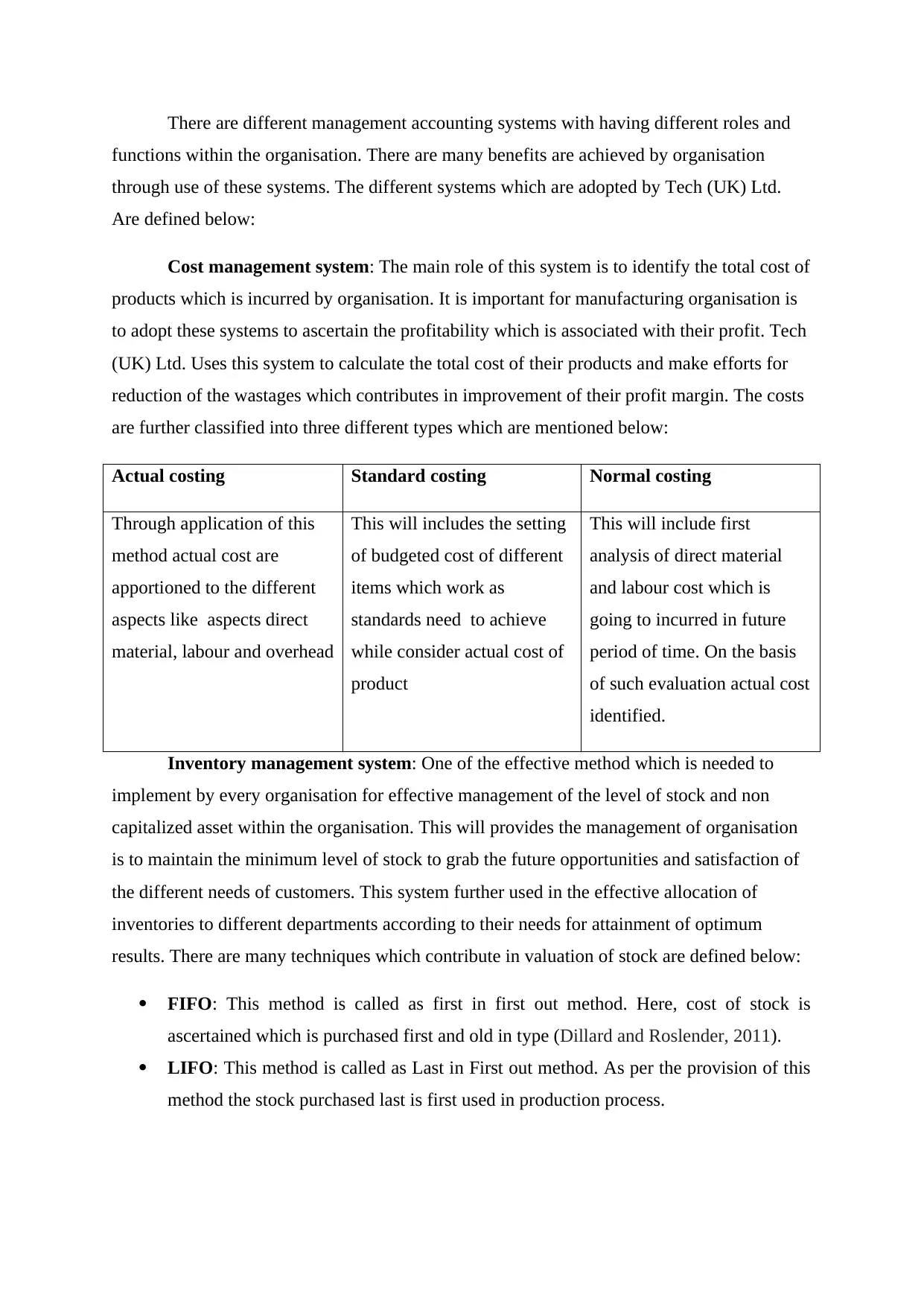
There are different management accounting systems with having different roles and
functions within the organisation. There are many benefits are achieved by organisation
through use of these systems. The different systems which are adopted by Tech (UK) Ltd.
Are defined below:
Cost management system: The main role of this system is to identify the total cost of
products which is incurred by organisation. It is important for manufacturing organisation is
to adopt these systems to ascertain the profitability which is associated with their profit. Tech
(UK) Ltd. Uses this system to calculate the total cost of their products and make efforts for
reduction of the wastages which contributes in improvement of their profit margin. The costs
are further classified into three different types which are mentioned below:
Actual costing Standard costing Normal costing
Through application of this
method actual cost are
apportioned to the different
aspects like aspects direct
material, labour and overhead
This will includes the setting
of budgeted cost of different
items which work as
standards need to achieve
while consider actual cost of
product
This will include first
analysis of direct material
and labour cost which is
going to incurred in future
period of time. On the basis
of such evaluation actual cost
identified.
Inventory management system: One of the effective method which is needed to
implement by every organisation for effective management of the level of stock and non
capitalized asset within the organisation. This will provides the management of organisation
is to maintain the minimum level of stock to grab the future opportunities and satisfaction of
the different needs of customers. This system further used in the effective allocation of
inventories to different departments according to their needs for attainment of optimum
results. There are many techniques which contribute in valuation of stock are defined below:
FIFO: This method is called as first in first out method. Here, cost of stock is
ascertained which is purchased first and old in type (Dillard and Roslender, 2011).
LIFO: This method is called as Last in First out method. As per the provision of this
method the stock purchased last is first used in production process.
functions within the organisation. There are many benefits are achieved by organisation
through use of these systems. The different systems which are adopted by Tech (UK) Ltd.
Are defined below:
Cost management system: The main role of this system is to identify the total cost of
products which is incurred by organisation. It is important for manufacturing organisation is
to adopt these systems to ascertain the profitability which is associated with their profit. Tech
(UK) Ltd. Uses this system to calculate the total cost of their products and make efforts for
reduction of the wastages which contributes in improvement of their profit margin. The costs
are further classified into three different types which are mentioned below:
Actual costing Standard costing Normal costing
Through application of this
method actual cost are
apportioned to the different
aspects like aspects direct
material, labour and overhead
This will includes the setting
of budgeted cost of different
items which work as
standards need to achieve
while consider actual cost of
product
This will include first
analysis of direct material
and labour cost which is
going to incurred in future
period of time. On the basis
of such evaluation actual cost
identified.
Inventory management system: One of the effective method which is needed to
implement by every organisation for effective management of the level of stock and non
capitalized asset within the organisation. This will provides the management of organisation
is to maintain the minimum level of stock to grab the future opportunities and satisfaction of
the different needs of customers. This system further used in the effective allocation of
inventories to different departments according to their needs for attainment of optimum
results. There are many techniques which contribute in valuation of stock are defined below:
FIFO: This method is called as first in first out method. Here, cost of stock is
ascertained which is purchased first and old in type (Dillard and Roslender, 2011).
LIFO: This method is called as Last in First out method. As per the provision of this
method the stock purchased last is first used in production process.
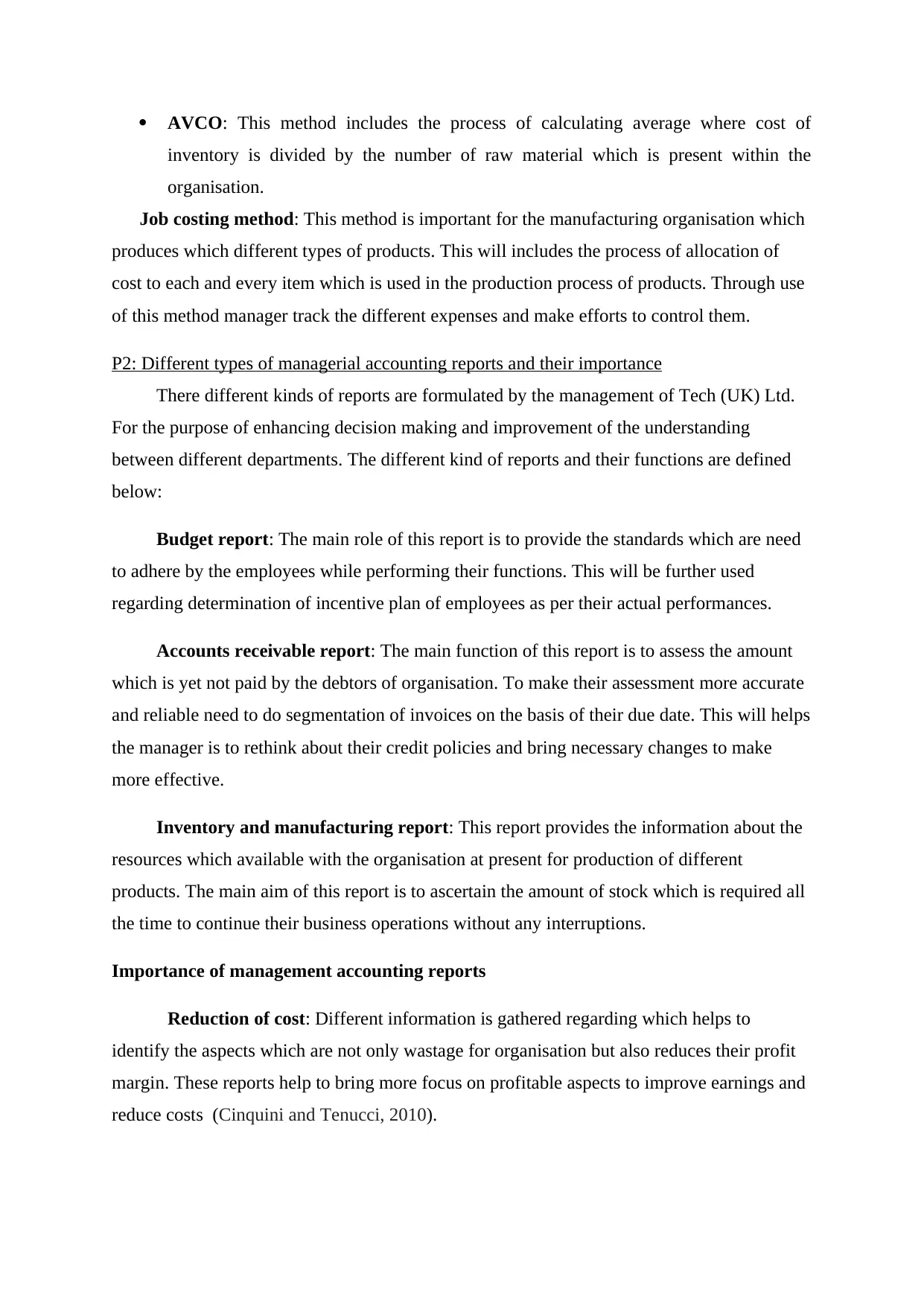
AVCO: This method includes the process of calculating average where cost of
inventory is divided by the number of raw material which is present within the
organisation.
Job costing method: This method is important for the manufacturing organisation which
produces which different types of products. This will includes the process of allocation of
cost to each and every item which is used in the production process of products. Through use
of this method manager track the different expenses and make efforts to control them.
P2: Different types of managerial accounting reports and their importance
There different kinds of reports are formulated by the management of Tech (UK) Ltd.
For the purpose of enhancing decision making and improvement of the understanding
between different departments. The different kind of reports and their functions are defined
below:
Budget report: The main role of this report is to provide the standards which are need
to adhere by the employees while performing their functions. This will be further used
regarding determination of incentive plan of employees as per their actual performances.
Accounts receivable report: The main function of this report is to assess the amount
which is yet not paid by the debtors of organisation. To make their assessment more accurate
and reliable need to do segmentation of invoices on the basis of their due date. This will helps
the manager is to rethink about their credit policies and bring necessary changes to make
more effective.
Inventory and manufacturing report: This report provides the information about the
resources which available with the organisation at present for production of different
products. The main aim of this report is to ascertain the amount of stock which is required all
the time to continue their business operations without any interruptions.
Importance of management accounting reports
Reduction of cost: Different information is gathered regarding which helps to
identify the aspects which are not only wastage for organisation but also reduces their profit
margin. These reports help to bring more focus on profitable aspects to improve earnings and
reduce costs (Cinquini and Tenucci, 2010).
inventory is divided by the number of raw material which is present within the
organisation.
Job costing method: This method is important for the manufacturing organisation which
produces which different types of products. This will includes the process of allocation of
cost to each and every item which is used in the production process of products. Through use
of this method manager track the different expenses and make efforts to control them.
P2: Different types of managerial accounting reports and their importance
There different kinds of reports are formulated by the management of Tech (UK) Ltd.
For the purpose of enhancing decision making and improvement of the understanding
between different departments. The different kind of reports and their functions are defined
below:
Budget report: The main role of this report is to provide the standards which are need
to adhere by the employees while performing their functions. This will be further used
regarding determination of incentive plan of employees as per their actual performances.
Accounts receivable report: The main function of this report is to assess the amount
which is yet not paid by the debtors of organisation. To make their assessment more accurate
and reliable need to do segmentation of invoices on the basis of their due date. This will helps
the manager is to rethink about their credit policies and bring necessary changes to make
more effective.
Inventory and manufacturing report: This report provides the information about the
resources which available with the organisation at present for production of different
products. The main aim of this report is to ascertain the amount of stock which is required all
the time to continue their business operations without any interruptions.
Importance of management accounting reports
Reduction of cost: Different information is gathered regarding which helps to
identify the aspects which are not only wastage for organisation but also reduces their profit
margin. These reports help to bring more focus on profitable aspects to improve earnings and
reduce costs (Cinquini and Tenucci, 2010).
⊘ This is a preview!⊘
Do you want full access?
Subscribe today to unlock all pages.

Trusted by 1+ million students worldwide
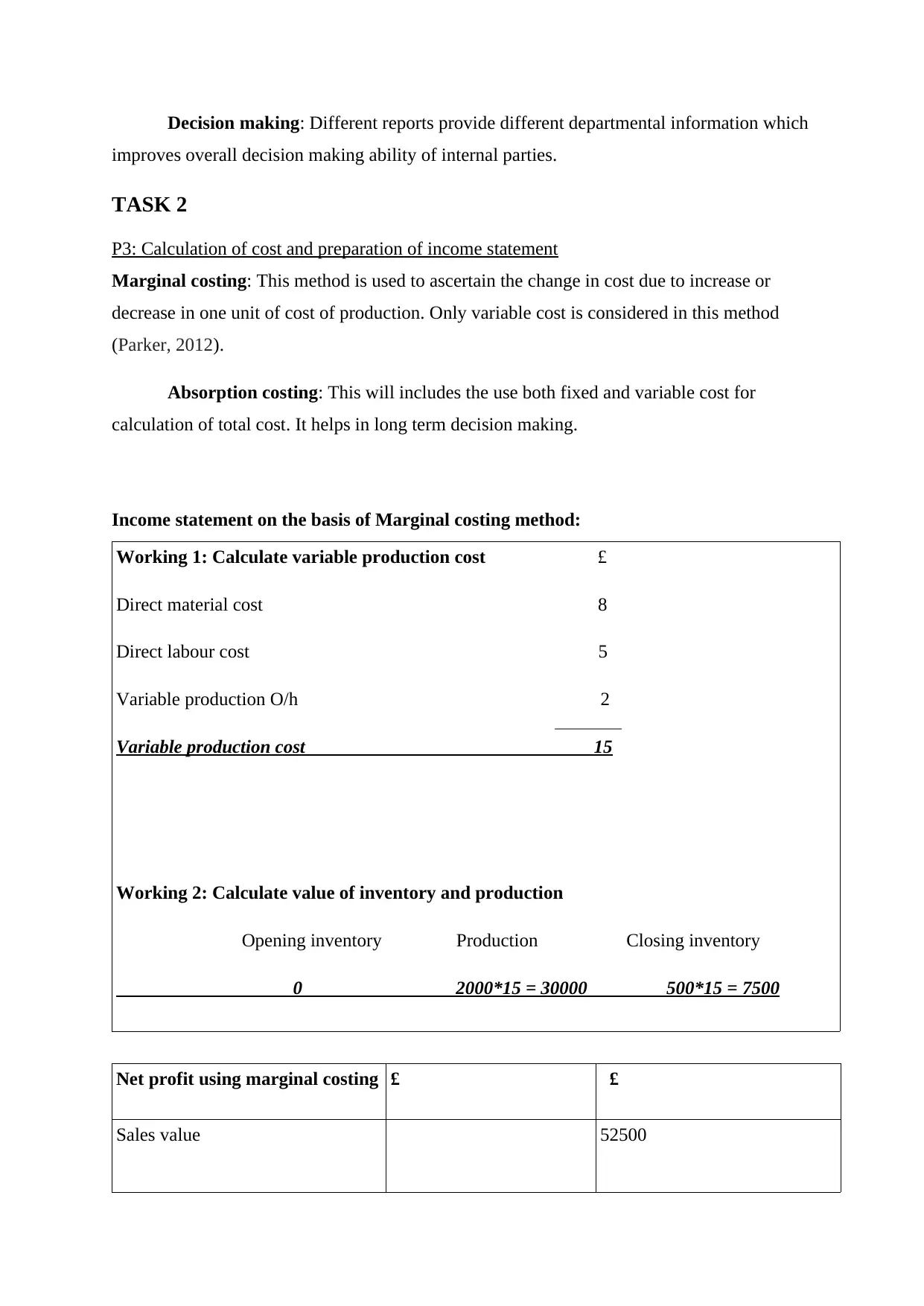
Decision making: Different reports provide different departmental information which
improves overall decision making ability of internal parties.
TASK 2
P3: Calculation of cost and preparation of income statement
Marginal costing: This method is used to ascertain the change in cost due to increase or
decrease in one unit of cost of production. Only variable cost is considered in this method
(Parker, 2012).
Absorption costing: This will includes the use both fixed and variable cost for
calculation of total cost. It helps in long term decision making.
Income statement on the basis of Marginal costing method:
Working 1: Calculate variable production cost £
Direct material cost 8
Direct labour cost 5
Variable production O/h 2
Variable production cost 15
Working 2: Calculate value of inventory and production
Opening inventory Production Closing inventory
0 2000*15 = 30000 500*15 = 7500
Net profit using marginal costing £ £
Sales value 52500
improves overall decision making ability of internal parties.
TASK 2
P3: Calculation of cost and preparation of income statement
Marginal costing: This method is used to ascertain the change in cost due to increase or
decrease in one unit of cost of production. Only variable cost is considered in this method
(Parker, 2012).
Absorption costing: This will includes the use both fixed and variable cost for
calculation of total cost. It helps in long term decision making.
Income statement on the basis of Marginal costing method:
Working 1: Calculate variable production cost £
Direct material cost 8
Direct labour cost 5
Variable production O/h 2
Variable production cost 15
Working 2: Calculate value of inventory and production
Opening inventory Production Closing inventory
0 2000*15 = 30000 500*15 = 7500
Net profit using marginal costing £ £
Sales value 52500
Paraphrase This Document
Need a fresh take? Get an instant paraphrase of this document with our AI Paraphraser

Less: Variable costs
Opening stock
Cost of production
Closing stock
Variable sales overheads
Contribution
Less Fixed costs:
Fixed Production overheads
Fixed Selling overheads
Net loss
0
30000
(7500)
15000
10000
(22500)
(7875)
22125
(25000)
(2875)
Income statement on the basis of Absorption costing method:
Selling Price per unit £35
Unit costs
Direct materials cost £8
Direct Labour cost £5
Variable Production overhead £2
Variable sales overhead £5.25
Budgeted production for the period is 3000
units
Fixed cost for a month:
Production overhead: In this budgeted cost is £15,000and Actual cost is £10,000
Opening stock
Cost of production
Closing stock
Variable sales overheads
Contribution
Less Fixed costs:
Fixed Production overheads
Fixed Selling overheads
Net loss
0
30000
(7500)
15000
10000
(22500)
(7875)
22125
(25000)
(2875)
Income statement on the basis of Absorption costing method:
Selling Price per unit £35
Unit costs
Direct materials cost £8
Direct Labour cost £5
Variable Production overhead £2
Variable sales overhead £5.25
Budgeted production for the period is 3000
units
Fixed cost for a month:
Production overhead: In this budgeted cost is £15,000and Actual cost is £10,000

Selling cost: In this budgeted cost is £10,000 and Actual cost is £7875
Absorption costing working notes
Working Note 1: Calculate full production cost
Direct material £8
Direct labour £5
Variable cost £2
Fixed cost £5
Total £20
Working Note 2: calculate value of inventory and production
Opening inventory Production Closing inventory
0 2,000*20 = £40000 500*20 = £10000
Working Note 3: under/ over absorbed fixed production overhead
Actual fixed production: £15000
Fixed overhead: £10000
Total £5000(under absorbed)
Net profit using absorption costing £ £
Sales value
(-) Cost of Sales:
Opening stock
Cost of production
Closing stock
0
40000
(10000)
52500
(30000)
Absorption costing working notes
Working Note 1: Calculate full production cost
Direct material £8
Direct labour £5
Variable cost £2
Fixed cost £5
Total £20
Working Note 2: calculate value of inventory and production
Opening inventory Production Closing inventory
0 2,000*20 = £40000 500*20 = £10000
Working Note 3: under/ over absorbed fixed production overhead
Actual fixed production: £15000
Fixed overhead: £10000
Total £5000(under absorbed)
Net profit using absorption costing £ £
Sales value
(-) Cost of Sales:
Opening stock
Cost of production
Closing stock
0
40000
(10000)
52500
(30000)
⊘ This is a preview!⊘
Do you want full access?
Subscribe today to unlock all pages.

Trusted by 1+ million students worldwide
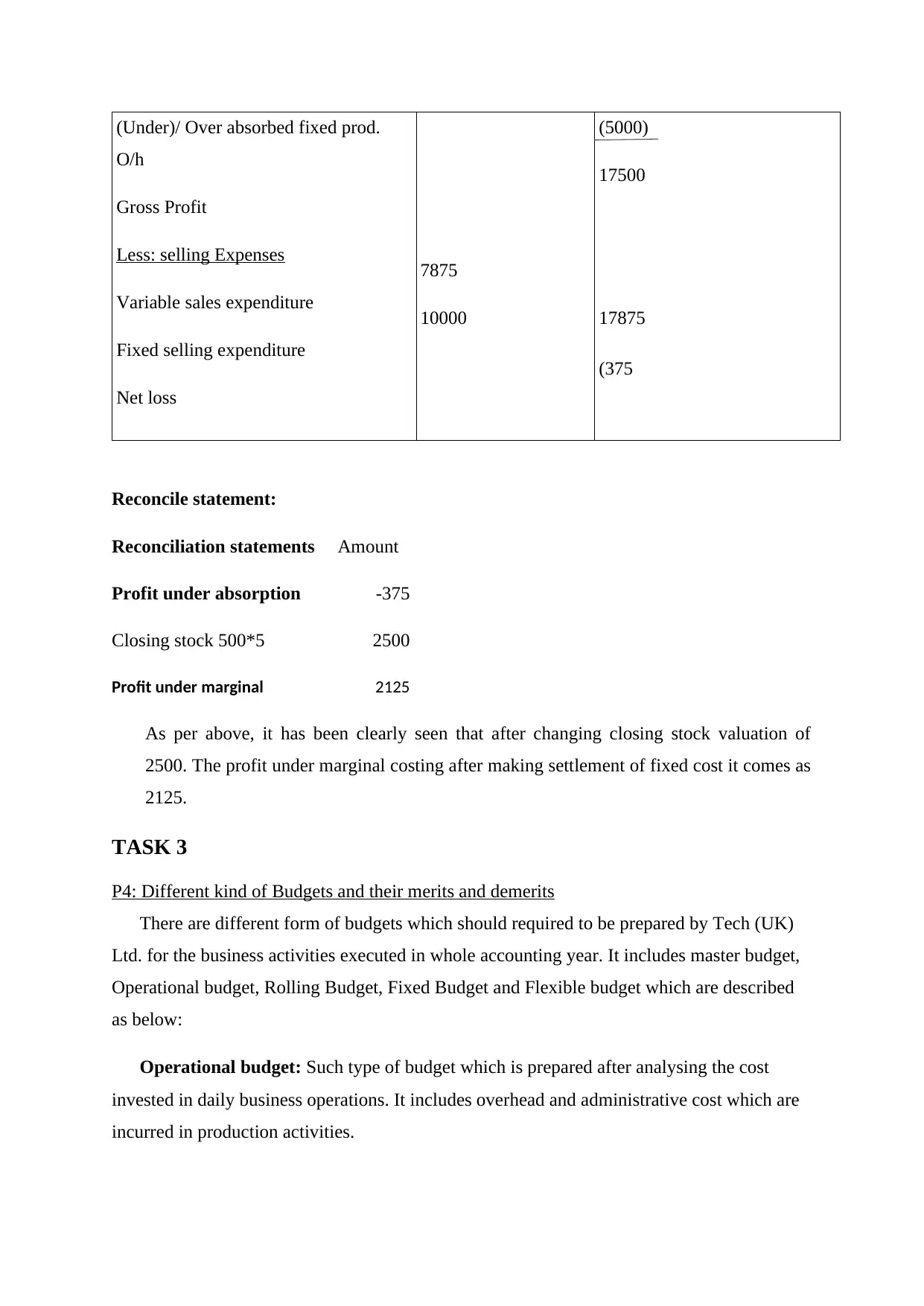
(Under)/ Over absorbed fixed prod.
O/h
Gross Profit
Less: selling Expenses
Variable sales expenditure
Fixed selling expenditure
Net loss
7875
10000
(5000)
17500
17875
(375
Reconcile statement:
Reconciliation statements Amount
Profit under absorption -375
Closing stock 500*5 2500
Profit under marginal 2125
As per above, it has been clearly seen that after changing closing stock valuation of
2500. The profit under marginal costing after making settlement of fixed cost it comes as
2125.
TASK 3
P4: Different kind of Budgets and their merits and demerits
There are different form of budgets which should required to be prepared by Tech (UK)
Ltd. for the business activities executed in whole accounting year. It includes master budget,
Operational budget, Rolling Budget, Fixed Budget and Flexible budget which are described
as below:
Operational budget: Such type of budget which is prepared after analysing the cost
invested in daily business operations. It includes overhead and administrative cost which are
incurred in production activities.
O/h
Gross Profit
Less: selling Expenses
Variable sales expenditure
Fixed selling expenditure
Net loss
7875
10000
(5000)
17500
17875
(375
Reconcile statement:
Reconciliation statements Amount
Profit under absorption -375
Closing stock 500*5 2500
Profit under marginal 2125
As per above, it has been clearly seen that after changing closing stock valuation of
2500. The profit under marginal costing after making settlement of fixed cost it comes as
2125.
TASK 3
P4: Different kind of Budgets and their merits and demerits
There are different form of budgets which should required to be prepared by Tech (UK)
Ltd. for the business activities executed in whole accounting year. It includes master budget,
Operational budget, Rolling Budget, Fixed Budget and Flexible budget which are described
as below:
Operational budget: Such type of budget which is prepared after analysing the cost
invested in daily business operations. It includes overhead and administrative cost which are
incurred in production activities.
Paraphrase This Document
Need a fresh take? Get an instant paraphrase of this document with our AI Paraphraser
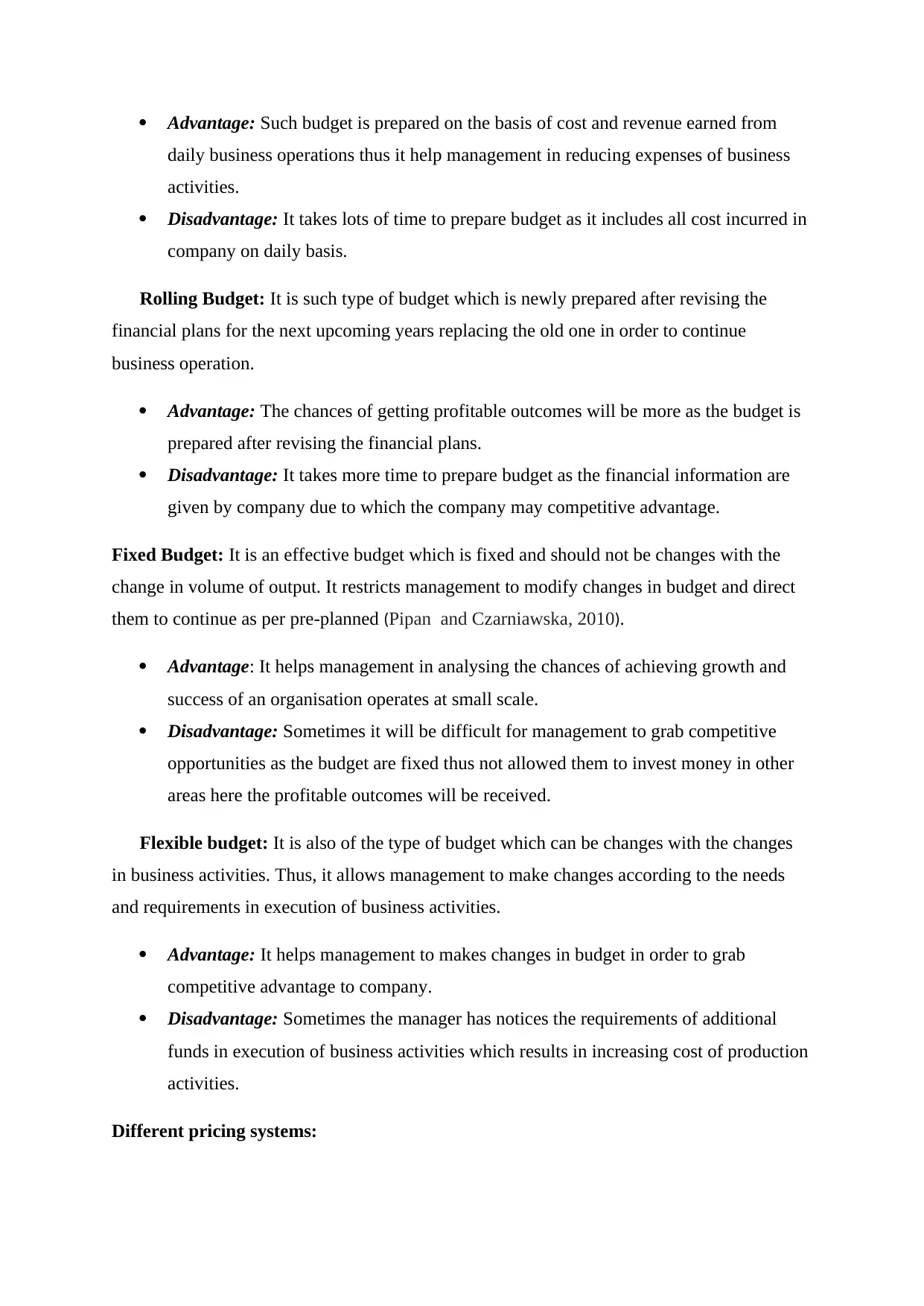
Advantage: Such budget is prepared on the basis of cost and revenue earned from
daily business operations thus it help management in reducing expenses of business
activities.
Disadvantage: It takes lots of time to prepare budget as it includes all cost incurred in
company on daily basis.
Rolling Budget: It is such type of budget which is newly prepared after revising the
financial plans for the next upcoming years replacing the old one in order to continue
business operation.
Advantage: The chances of getting profitable outcomes will be more as the budget is
prepared after revising the financial plans.
Disadvantage: It takes more time to prepare budget as the financial information are
given by company due to which the company may competitive advantage.
Fixed Budget: It is an effective budget which is fixed and should not be changes with the
change in volume of output. It restricts management to modify changes in budget and direct
them to continue as per pre-planned (Pipan and Czarniawska, 2010).
Advantage: It helps management in analysing the chances of achieving growth and
success of an organisation operates at small scale.
Disadvantage: Sometimes it will be difficult for management to grab competitive
opportunities as the budget are fixed thus not allowed them to invest money in other
areas here the profitable outcomes will be received.
Flexible budget: It is also of the type of budget which can be changes with the changes
in business activities. Thus, it allows management to make changes according to the needs
and requirements in execution of business activities.
Advantage: It helps management to makes changes in budget in order to grab
competitive advantage to company.
Disadvantage: Sometimes the manager has notices the requirements of additional
funds in execution of business activities which results in increasing cost of production
activities.
Different pricing systems:
daily business operations thus it help management in reducing expenses of business
activities.
Disadvantage: It takes lots of time to prepare budget as it includes all cost incurred in
company on daily basis.
Rolling Budget: It is such type of budget which is newly prepared after revising the
financial plans for the next upcoming years replacing the old one in order to continue
business operation.
Advantage: The chances of getting profitable outcomes will be more as the budget is
prepared after revising the financial plans.
Disadvantage: It takes more time to prepare budget as the financial information are
given by company due to which the company may competitive advantage.
Fixed Budget: It is an effective budget which is fixed and should not be changes with the
change in volume of output. It restricts management to modify changes in budget and direct
them to continue as per pre-planned (Pipan and Czarniawska, 2010).
Advantage: It helps management in analysing the chances of achieving growth and
success of an organisation operates at small scale.
Disadvantage: Sometimes it will be difficult for management to grab competitive
opportunities as the budget are fixed thus not allowed them to invest money in other
areas here the profitable outcomes will be received.
Flexible budget: It is also of the type of budget which can be changes with the changes
in business activities. Thus, it allows management to make changes according to the needs
and requirements in execution of business activities.
Advantage: It helps management to makes changes in budget in order to grab
competitive advantage to company.
Disadvantage: Sometimes the manager has notices the requirements of additional
funds in execution of business activities which results in increasing cost of production
activities.
Different pricing systems:
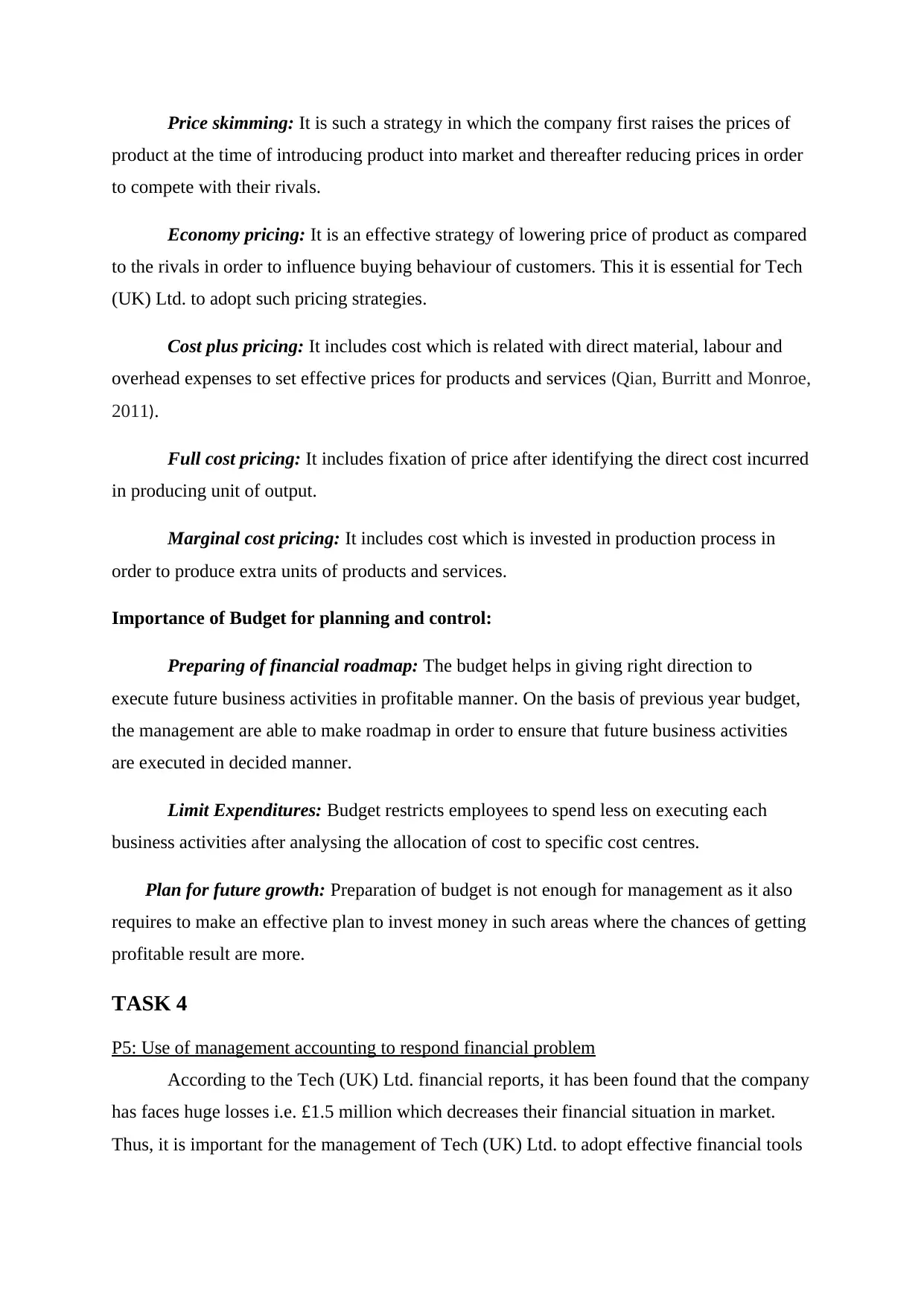
Price skimming: It is such a strategy in which the company first raises the prices of
product at the time of introducing product into market and thereafter reducing prices in order
to compete with their rivals.
Economy pricing: It is an effective strategy of lowering price of product as compared
to the rivals in order to influence buying behaviour of customers. This it is essential for Tech
(UK) Ltd. to adopt such pricing strategies.
Cost plus pricing: It includes cost which is related with direct material, labour and
overhead expenses to set effective prices for products and services (Qian, Burritt and Monroe,
2011).
Full cost pricing: It includes fixation of price after identifying the direct cost incurred
in producing unit of output.
Marginal cost pricing: It includes cost which is invested in production process in
order to produce extra units of products and services.
Importance of Budget for planning and control:
Preparing of financial roadmap: The budget helps in giving right direction to
execute future business activities in profitable manner. On the basis of previous year budget,
the management are able to make roadmap in order to ensure that future business activities
are executed in decided manner.
Limit Expenditures: Budget restricts employees to spend less on executing each
business activities after analysing the allocation of cost to specific cost centres.
Plan for future growth: Preparation of budget is not enough for management as it also
requires to make an effective plan to invest money in such areas where the chances of getting
profitable result are more.
TASK 4
P5: Use of management accounting to respond financial problem
According to the Tech (UK) Ltd. financial reports, it has been found that the company
has faces huge losses i.e. £1.5 million which decreases their financial situation in market.
Thus, it is important for the management of Tech (UK) Ltd. to adopt effective financial tools
product at the time of introducing product into market and thereafter reducing prices in order
to compete with their rivals.
Economy pricing: It is an effective strategy of lowering price of product as compared
to the rivals in order to influence buying behaviour of customers. This it is essential for Tech
(UK) Ltd. to adopt such pricing strategies.
Cost plus pricing: It includes cost which is related with direct material, labour and
overhead expenses to set effective prices for products and services (Qian, Burritt and Monroe,
2011).
Full cost pricing: It includes fixation of price after identifying the direct cost incurred
in producing unit of output.
Marginal cost pricing: It includes cost which is invested in production process in
order to produce extra units of products and services.
Importance of Budget for planning and control:
Preparing of financial roadmap: The budget helps in giving right direction to
execute future business activities in profitable manner. On the basis of previous year budget,
the management are able to make roadmap in order to ensure that future business activities
are executed in decided manner.
Limit Expenditures: Budget restricts employees to spend less on executing each
business activities after analysing the allocation of cost to specific cost centres.
Plan for future growth: Preparation of budget is not enough for management as it also
requires to make an effective plan to invest money in such areas where the chances of getting
profitable result are more.
TASK 4
P5: Use of management accounting to respond financial problem
According to the Tech (UK) Ltd. financial reports, it has been found that the company
has faces huge losses i.e. £1.5 million which decreases their financial situation in market.
Thus, it is important for the management of Tech (UK) Ltd. to adopt effective financial tools
⊘ This is a preview!⊘
Do you want full access?
Subscribe today to unlock all pages.

Trusted by 1+ million students worldwide
1 out of 17
Related Documents
Your All-in-One AI-Powered Toolkit for Academic Success.
+13062052269
info@desklib.com
Available 24*7 on WhatsApp / Email
![[object Object]](/_next/static/media/star-bottom.7253800d.svg)
Unlock your academic potential
Copyright © 2020–2025 A2Z Services. All Rights Reserved. Developed and managed by ZUCOL.





